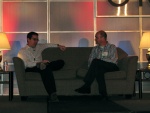|
Joe Kraus and Chris Anderson (click to enlarge)
|
Chris Anderson is talking about the long tail. When you plot a powerlaw on a log-log scale, you get an line with negative slope. When you plot movie revenues, however, you don't get a nice line, you get a line with a drop at about rank 1000. Why? Because if you don't get theater distribution, you don't get money.
Traditionally, businesses have ignored this "cut off part," the long tail, because it was considered economically non-viable. Chris goes through the history of the growth of the long tail in various industries including network vs. cable TV and the number of products on supermarket shelfs.
In the 1990's we ran into the tyranny of choice (over 160 brands of toothpaste. "Which would I choose?"). Information can combat this.
Google AdWords are an example of taking advantage of the long tail. So is iTunes, eBay, Amazon, and CapitalOne. CapitalOne is an interesting example, because they have a fine-grained view of credit risk for their customers that allows them to offer the right card (from CapitalOne's perspective) to each customer.
The signal-to-noise ratio degrades as you move down the tail, so to drive demand down the tail, you have to have good exploration and filtering technologies to let people find the gems in all the garbage.
To have a long tail, you have to have a popular draw. Amazon recommendations drive people down the tail, but they enter at the top, looking for someone they knew because they're popular. He uses an example where you start with Brittany Spears (sales rank #384) and in four clicks are down to an unknown band from the 80's with sales rank of 32,000.
Another example is DVDStation, which allows customers to rent from over 5000 titles without the shelf space. Small retailers can now benefit from the long tail in DVD sales.
Should prices get lower or higher as you move down the tail? For things people want, like entertainment, the price should be lowered to encourage exploration. For things people need, like information, you can raise the price.
The long tail is big in secondary markets like user goods, gray goods, and overstock goods.
Is infinite shelf space like Moore's law or like steam? That is, does it break the game, as Moore's law does, or fit in with conventional economics?
In the follow-on conversation, Joe Kraus (CEO of JotSpot) is discussing how JotSpot is about recognizing the long tail in software, especially Web applications. He says the VCs don't want to hear about "going small to get big." The key thing to understand that the cost of acquiring can be low, but you have to build your model, and your system, around that idea. The key to a longtail business is massive inventory. The only way you can do that is to have other people build it for you. You have to be a platform for others. Good advice.





